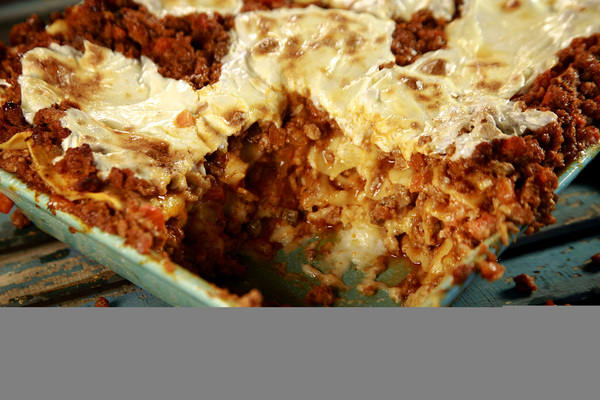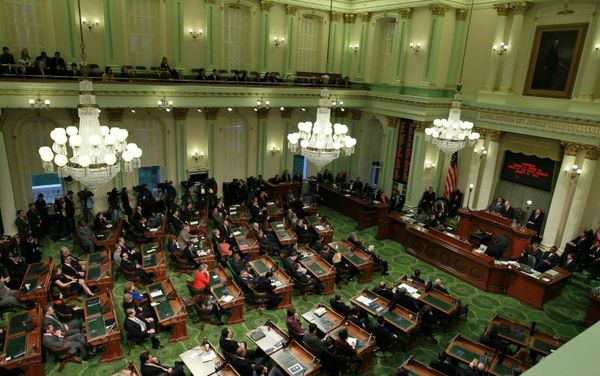
Fall is a season that many of us look forward to, not only for the weather and the sports and the holidays, but because that's when publishers tend to drop their best and often heftiest cookbooks. This year's collection is a terrific one, loaded with books from notable chefs and much-loved cookbook writers and television personalities (Anthony Bourdain! Alton Brown!), with new baking books, conveniently in time for cookie season. Whether you're looking for cookbooks to gift, cookbooks to cook from for your own holiday tables or just want something to read while you watch football, we've highlighted 10 of our favorites.
"Everything I Want to Eat" by Jessica Koslow (Abrams, $40)
This is the first cookbook from the chef and owner of Sqirl, the relentlessly on-trend East Hollywood toast shop. Sqirl, of course, is far more than a toast shop. Jessica Koslow's tiny restaurant articulates much of what L.A. is eating these days: beautifully orchestrated grain bowls, things-on-toast, homey dishes invariably topped with eggs or house lacto-fermented hot sauce, or the gorgeous jams that were Koslow's gateway product and our gateway drug to toast in the first place. Koslow's cookbook is far more than 100 recipes for all those things. It's built like an art house book with lovely photography, lots of white-on-white design and weird-pretty compositions; and the photos include not only the food and the cooks but neighborhood regulars, as if it had been somehow crowd-sourced. So you can learn to make Koslow's Malva pudding cakes, her sorrel pesto rice bowls and strawberry rose geranium jam _ as well as more intricate recipes that recall Koslow's classical training. Rabbit ballotine!
"How to Bake Everything" by Mark Bittman (Houghton Mifflin Harcourt, $35)
Mark Bittman, the former New York Times food columnist, has written 20 books. His latest is in the vein of his popular cookbook, "How to Cook Everything." Because cooking is different from baking, and because we can never have too many dessert-focused cookbooks, especially in time for the holiday season. It's a predictably massive book, with the heft and presentation of Webster's dictionary. With over 2,000 recipes, plenty of the variations that the author is known for, and many step-by-steps and instructive sidebars, the book is exhaustive, as you'd hope it would be, given the title. It's illustrated with small black-and-white drawings rather than glossy photographs, which adds to the school dictionary feel. But it's also driven by Bittman's folksy voice, which leavens the didacticism and makes the book engaging and comfortable.
"Dorie's Cookies" by Dorie Greenspan (Houghton Mifflin Harcourt, $35)
Dorie Greenspan has written 11 cookbooks and many columns, run a baking club and a popular food blog, and done more than probably anyone to bring French macarons into our kitchens. But she has not, until now, written a book specifically about cookies. That sound you hear is holiday bakers clapping. Greenspan gives recipes for 170 cookies: classic cookies, bar cookies, savory cookies, refrigerator cookies and maybe best of all, cookies from her now-closed Beurre & Sel New York City cookie shop. This is a nice big purple book filled with cookie photography from Davide Luciano and lots of handy tips on techniques, gear, storing (see: holiday gifting) and what Greenspan calls "playing around." What this means is that every so often, Greenspan gives us a recipe's back story, a way to tweak the process or a bit of characteristic kitchen advice. Want a really good holiday gift? Wrap the book with a batch of cookies, as well as some refrigerated dough, then invite yourself over around tea time.
"Mozza at Home" by Nancy Silverton with Carolynn Carreno (Knopf, $35)
This is the seventh book from Nancy Silverton, the co-owner of the Mozza group of restaurants, the founder of La Brea Bakery, the recipient of many culinary awards and a woman who is probably the culinary soul of Los Angeles. Her latest book is a kind of companion piece to "The Mozza Cookbook," a collection of menus of what Siilverton likes to cook at home _ or more specifically, what she cooked at her home in L.A. and her other home in Umbria as a way to reboot her love of cooking after years spent primarily cooking in her restaurants. Thus we have simple dishes built around market produce, plates of roasted grapes and charred peppers and marinated olives with cheese. There's braised oxtails and roasted chicken and Silverton's near-legendary hamburgers, even a recipe for Frito pie. Threaded through the book, among the 150 dishes and the pretty photos from Christopher Hirsheimer, is a running commentary from Silverton, about how and why she cooks, what inspires her, what she thinks about various ingredients and cooking styles. As she is behind Osteria Mozza's mozarella bar, where she seems to be whenever you happen to show up for dinner, Silverton is engaging and funny and astonishingly knowledgeable _ the difference here is that she's not cooking while she talks: you are.
"EveryDayCook: This Time It's Personal" by Alton Brown (Ballantine Books, $35)
Alton Brown, of course, is the former host of "Good Eats" _ which ran for 14 seasons on the Food Network _ and some other shows, such as "Cutthroat Kitchen" and "Iron Chef America," as well as author of eight cookbooks. His latest, Brown's first in five years, is composed of the 100 or so recipes he actually cooks for himself. What this means is less of the MacGyver-ing that he was known for and more everyday stuff, recipes for butterscotch pudding and one-pot chicken and little brown biscuits. This is still Brown, though, so there's a recipe for pancakes made with nitrous oxide, as well as a "hack" for a four-ingredient snack made from saltines, hot sauce, mustard powder _ and clarified butter. "Welcome to my world," Brown writes in the introduction, explaining why all the stuff (silverware, plates, U.S. Army forks, a Mercury hubcap, his BMW, named Klaus) in the photographs is his stuff. He also explains the conceit of the photography, which was all taken with an iPhone 6s. "I'm a bit of a control freak," Brown writes. As if we didn't already know that, and as if that was not one of the reasons we've loved him all along.
"Appetites: A Cookbook" by Anthony Bourdain (Ecco, $37.50)
Anthony Bourdain has been busy for the last decade, hosting "No Reservations," "The Layover" and "Parts Unknown" on television, publishing other people's books and slurping noodles with President Obama in Vietnam. So he can be forgiven for not doing anything as mundane as writing a cookbook. This is what he's just done, though: his first since the 2004 "Les Halles Cookbook." "Appetites," unsurprisingly, is not a boring book. The cover looks like a Jean-Michel Basquiat painting (it was done by Ralph Steadman, who also did the cover of "Fear and Loathing in Las Vegas"); the last few pages are a graphic pull-out poster describing the perfect hamburger, as written by Nathan Myhrvold. And in between? Actual recipes, for tuna salad, chicken pot pie, and macaroni and cheese. There's a chapter on Thanksgiving. And if all that sounds disturbingly, well, normal, rest assured that there are also recipes for things that sound more Bourdain-like _ halibut poached in duck fat, budae jiggae, or Korean Army stew (shown in an Army helmet) _ as well as plenty of pictures of Le Bernardin chef Eric Ripert dribbling gravy down his beautiful French chin. It is, of course, a fun and irreverent read _ vintage Bourdain, but with a recipe for lasagna.
"The Red Rooster Cookbook" by Marcus Samuelsson, with Roy Finamore and April Reynolds (Houghton Mifflin Harcourt, $37.50)
When chef Marcus Samuelsson opened his restaurant Red Rooster in Harlem in 2010, it was as kind of a mission statement. Named for a neighborhood speak-easy where James Baldwin used to drink, staffed with people from the community, serving "cross-cultural soul food," the restaurant was Samuelsson's ode to Harlem and its culture. There were many nested ironies in the project, of course, coming from a chef who was born in Ethiopia and raised in Sweden. But the chef was embracing his adopted neighborhood, and the cookbook that comes out of that project is a way to further it: the forward is by Hilton Als, the photography encompasses not only food but the people of the neighborhood, and the pages include other voices as well, from a local jazz pianist, and from a man who's worked at the Apollo Theater for half a century. But you are here for the food and Samuelsson does not disappoint. There are recipes for brown butter biscuits, jerk bacon and baked beans, whole fried fish with grits, and Red Rooster hot sauce. There's also food that channels his own roots as well as the neighborhood's: beef kitfo with awase, and lemon chicken with green harissa. And, lest we forget that Samuelsson has cooked at the White House and that President Obama has made a point of coming to the restaurant, there's a recipe for Obama's short ribs. Maybe make Samuelsson's cocktail (Yes, Chef), named after his memoir, while you make them.
"Taste of Persia" by Naomi Duguid (Artisan, $35)
Naomi Duguid has won a stack of awards for her cookbooks that's probably about as high as the stack of cookbooks she's written: gorgeous volumes that are equal parts food and anthropology. Her books are like travelogues and have covered the cuisines of China, Burma, Laos, Cambodia, Vietnam and Thailand. Duguid's latest book is about the area that was once the Persian Empire, or more specifically: Armenia, Azerbaijan, Georgia, Iran and Kurdistan. (If you're feeling embarrassingly under-traveled right now, you're hardly alone; Duguid, a Canadian, must have a passport as well-worn as Ban Ki-moon's.) The book helpfully begins with a map of the region in question, textured with the Caucasus Mountains and annotated with place names. And throughout the pages of recipes are photographs, many taken by Duguid, that illustrate the ingredients and techniques, landscapes and peoples, of the region. The recipes are straightforward and adaptive, with enough back story to interest historians but also accessible to fairly novice readers. Thus: emmer mushroom pilaf, Yerevan tongue salad and liver kebabs; but also: herbed yogurt soup, cucumber and tomato salad with sumac and mint, and roast chicken with Persian flavors. After the recipes, Duguid provides pages of travel notes, a note on wines and a pretty cool glossary: the cookbook as Lonely Planet guide.
"Land of Fish and Rice: Recipes From the Culinary Heart of China" by Fuchsia Dunlop (Norton, $35)
For Fuchsia Dunlop's fifth book, we are in Jiangnan, in the Lower Yangtze region of China, home to the city of Shanghai and known as "the land of fish and rice" _ hence the title of the cookbook. Dunlop, who trained as a chef in China at the Sichuan Institute of Higher Cuisine and is based in London, has written a number of lauded books on Chinese cooking, including cookbooks on Sichuan and Hunan cuisine. The recipes here are titled in English, Chinese characters and pinyin, the standard romanization of Mandarin, with lovely accompanying photographs by Yuki Sugiura and plenty of contextual narrative. Dunlop tells us where the recipes come from, the techniques involved, how to source particular ingredients and so on. Threaded throughout the book are useful sections: on regional drinks and useful equipment, on how to make basic recipes and how to plan a Chinese menu. Dunlop's prose is engaging and informative, and the recipes she chooses encompass the complex and the happily simple: stir-fried lettuce, for example, has four ingredients and two steps. You will learn much about regional Chinese food, and you will want to make these recipes (magical radishes, Monk Wensi's tofu thread soup) as soon as reasonably possible.
"Lucky Peach Presents Power Vegetables!" by Peter Meehan and the editors of Lucky Peach (Clarkson Potter, $35)
The latest in the series of cookbooks from the Lucky Peach folks, "Power Vegetables!" comes on the heels of "The Wurst of Lucky Peach," a cookbook devoted to sausages. Consider it a kind of corrective, or at least something to appease the vegetarians among us. This book, written with Lucky Peach editor Peter Meehan on point, divides said vegetable recipes into various camps: starters, salads, pies, soups, etc. That said, this isn't really about telling us all to cook seasonally or specifically healthfully but rather how to "approach vegetable cookery from a Lucky Peach perspective." Which is to say, a book that's "98 percent fun and 2 percent stupid." What does that mean? Lots of brightly colored graphics and photographs that are themselves mostly fun and a bit silly (one shows blue cheese dressing for a wedge salad also being poured over toy trucks and shoes), as well as recipes that one could say the same thing about: daikon with X.O. sauce, foil-wrapped vegetables, Kung Pao celeries, miso butterscotch. There are also Q & A's from Lucky Peach regulars such as Ivan Orkin and David Chang. This is not a completely vegetarian cookbook _ there's fish here _ and there are caveats _ no pasta recipes, no grain bowls _ that make it less predictable, more idiosyncratic. Because zucchini recipes can be hipsterized too.







